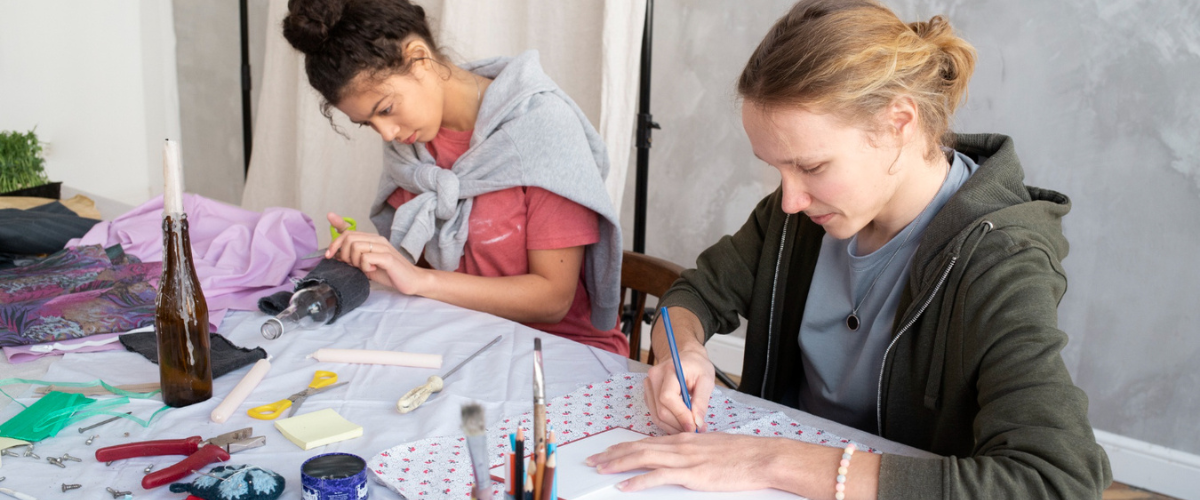Who is a textile designer?
A textile designer is a professional who specializes in creating designs for fabrics, textiles, and surface patterns. They combine their artistic skills with knowledge of textile materials, printing techniques, and color theory to develop unique and innovative designs for various applications. Textile designers may work in industries such as fashion, home furnishings, automotive, or technical textiles.
Their responsibilities typically include:
-
Designing patterns: Textile designers create original patterns, motifs, and designs that can be applied to fabrics. These designs can range from simple geometric patterns to intricate floral motifs or abstract compositions.
-
Color selection: Textile designers choose appropriate color palettes for their designs, considering factors such as market trends, target audience, and the intended application of the fabric.
-
Fabric experimentation: They explore different fabrics and materials, understanding their properties and capabilities. They experiment with various textile techniques such as weaving, printing, knitting, or embroidery to achieve the desired visual effect and texture.
-
Creating textile repeats: Textile designers develop repeating patterns or motifs that can be seamlessly tiled or repeated across a fabric’s surface. They ensure that the pattern seamlessly repeats both horizontally and vertically, creating a continuous design.
-
Collaboration: Textile designers often collaborate with other professionals, such as fashion designers, interior designers, or manufacturers, to develop designs that align with specific requirements or design briefs. They may need to adapt their designs to fit the intended product or fabric application.
-
Research and trend analysis: Textile designers stay informed about current fashion trends, market demands, and emerging design styles. They conduct research, analyze trend forecasts, and incorporate relevant influences into their designs.
-
Technical specifications: Textile designers create detailed technical specifications for their designs, including color codes, pattern scale, and instructions for fabric production. These specifications guide manufacturers in accurately reproducing the designs on a larger scale.
Textile designers can work as part of a design team in a textile studio, fashion house, or manufacturing company. Alternatively, they may choose to work independently as freelance designers, providing their services to clients or developing their own textile products.
How to become a textile designer?
-
Obtain a relevant education: Consider pursuing a Textile Design Courses or a related field such as fashion design, fine arts, or surface pattern design. Look for reputable colleges, universities, or art schools that offer programs specifically focused on textile design. Acquiring a formal education will provide you with a strong foundation in design principles, techniques, and textile technology.
-
Develop your artistic skills: Practice and refine your artistic abilities by experimenting with various techniques and mediums. This may involve sketching, painting, printmaking, digital design, or any other form of artistic expression. Explore different styles and techniques to develop your own unique aesthetic.
-
Gain knowledge of textiles: Study different types of fabrics, materials, dyes, and printing techniques used in textile design. Familiarize yourself with the characteristics and properties of various textiles, as this knowledge will be crucial when creating designs suitable for specific materials.
-
Learn design software: Become proficient in industry-standard design software such as Adobe Photoshop, Adobe Illustrator, or other digital design tools. These software programs are commonly used for creating digital designs, patterns, and textile repeats. Familiarity with these tools will enhance your design capabilities and make you more marketable.
-
Build a portfolio: Create a portfolio showcasing your best work. Include a variety of textile design projects that highlight your skills, creativity, and range. Your portfolio can consist of both physical samples and digital representations of your designs. Make sure to regularly update and refine your portfolio as you gain more experience and create new work.
-
Gain practical experience: Look for internships, apprenticeships, or entry-level positions in the textile industry. This will provide you with hands-on experience, exposure to real-world design projects, and an opportunity to learn from professionals in the field. Practical experience can be gained through textile design studios, fashion houses, textile manufacturers, or even freelancing for clients.
-
Networking: Attend industry events, trade shows, and exhibitions to network with professionals in the textile and fashion industry. Building connections with other designers, manufacturers, retailers, and industry experts can open doors to potential job opportunities or collaborations.
-
Stay updated on trends and industry developments: Keep yourself informed about current trends, emerging technologies, and market demands in the textile industry. Subscribe to relevant publications, follow influential designers, and participate in workshops or conferences to stay up-to-date with the latest developments in textile design.
-
Freelancing or employment: Decide whether you want to work as a freelance textile designer or seek employment with a design studio, fashion brand, or textile manufacturer. Freelancing offers flexibility and the opportunity to work on a variety of projects, while employment provides stability and the chance to work within a team environment.
-
Continuous learning: Textile design is a dynamic field, so continuous learning and professional development are essential. Stay curious, seek out new techniques, explore different design genres, and continue to refine your skills through practice and experimentation.
Remember, becoming a successful textile designer requires talent, dedication, and perseverance. It may take time to establish yourself in the industry, but with passion and hard work, you can pursue a rewarding career in textile design. The best Best Designing Institutes in Pune like International School Of Design Pune has multiple courses in Textile Design with onsite opportunities to start work and explore career options.



